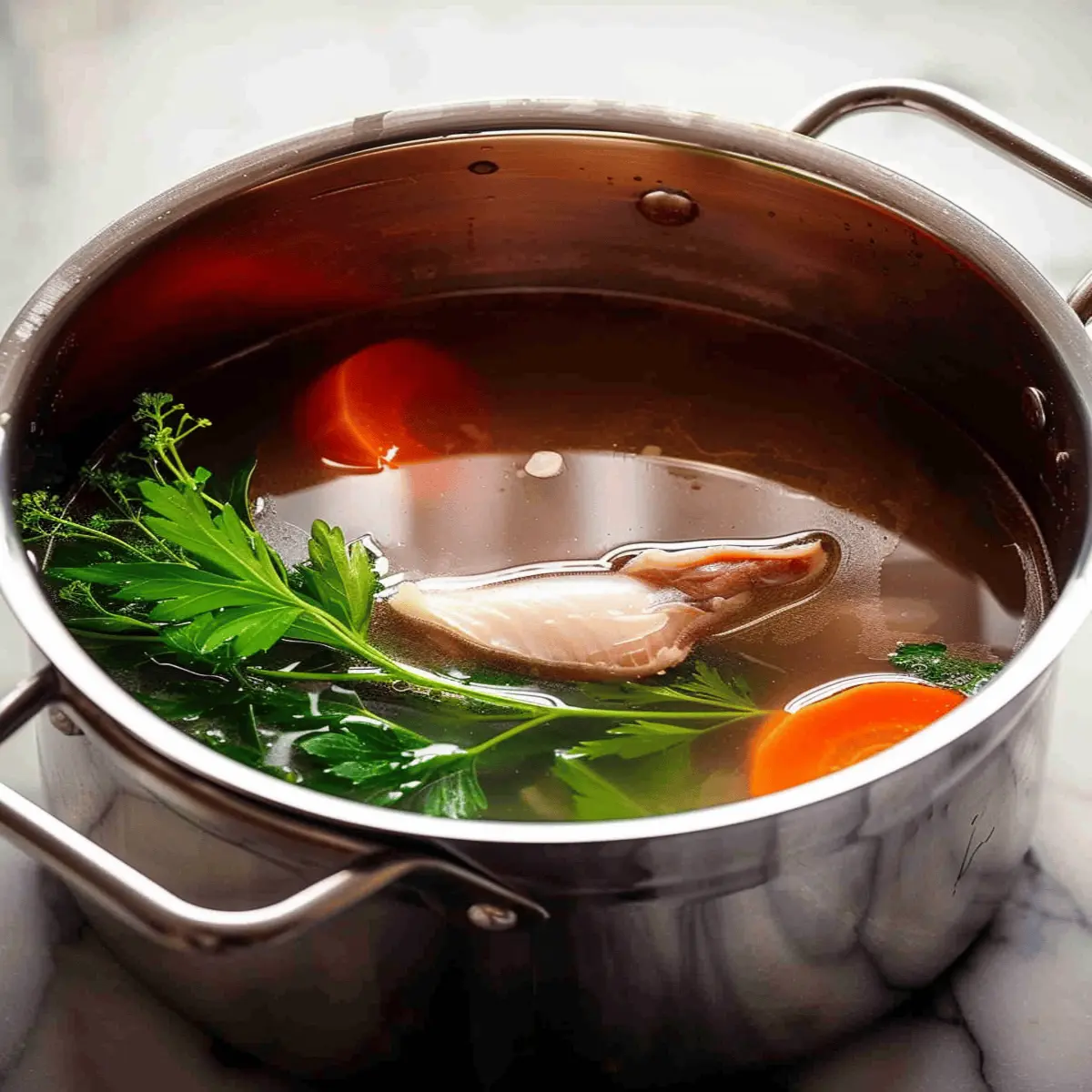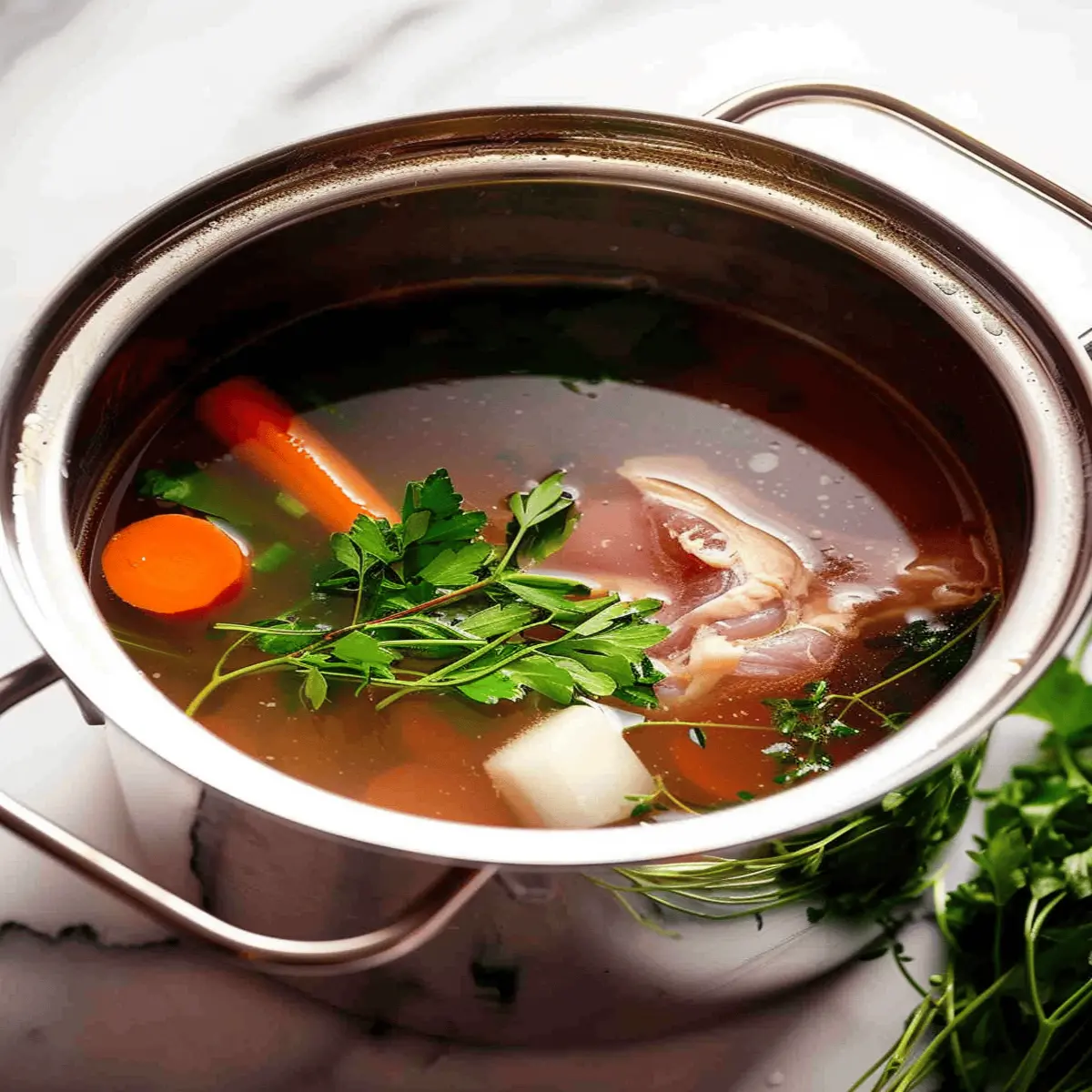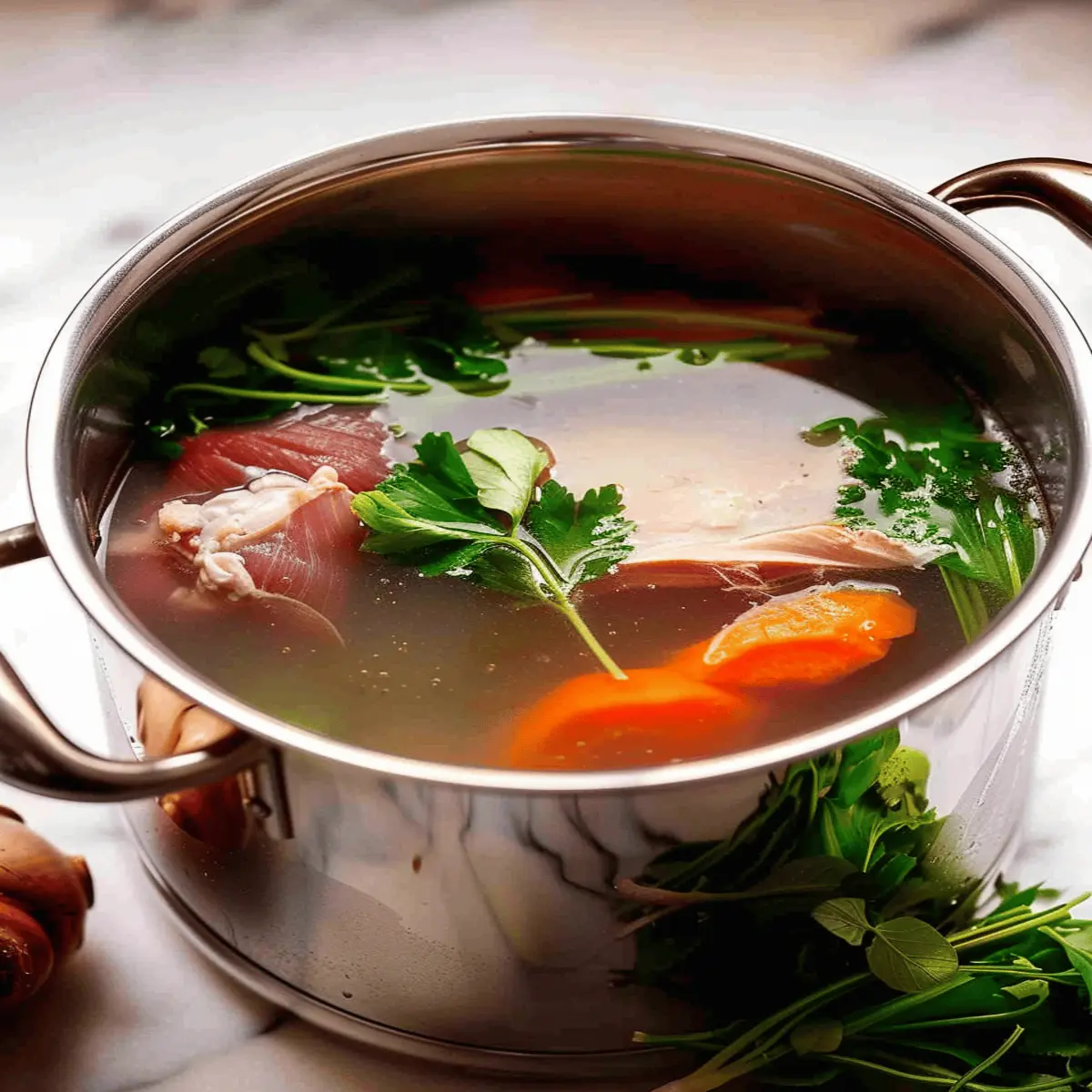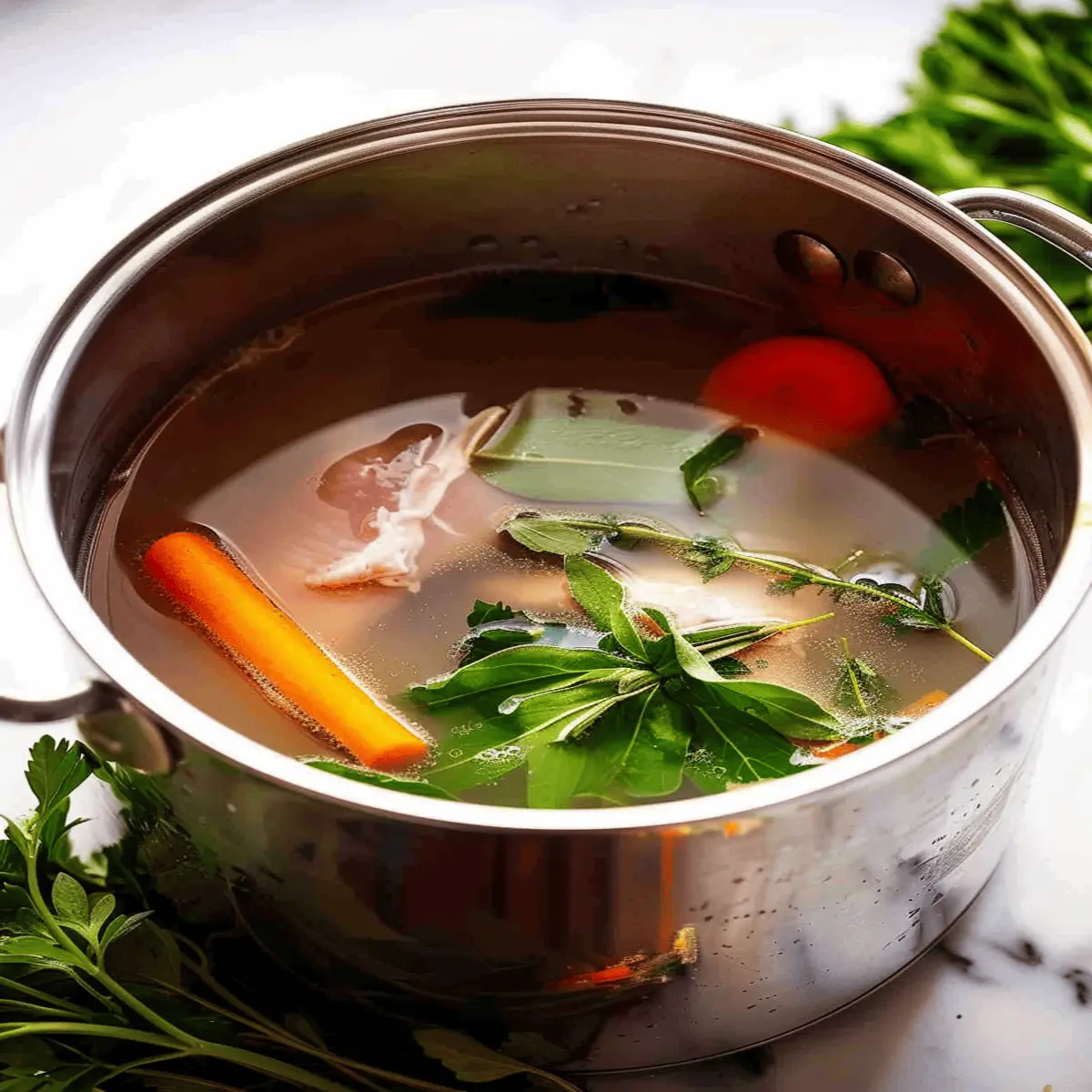Introduction to Chicken Stock
Why Homemade Chicken Stock is a Game-Changer
You might wonder why you should bother with homemade chicken stock when store-bought options are readily available. The answer is simple: homemade stock elevates your dishes to a whole new level. Imagine serving up a comforting soup or rich sauce, infused with layers of flavor that only homemade stock can provide. It’s like the secret ingredient that brings everything together.
When you make your own chicken stock, you control the ingredients, ensuring that everything is fresh, wholesome, and tailored to your taste. Store-bought stocks often contain preservatives, artificial flavors, and sodium, which can mask the natural deliciousness of your meals. According to the USDA, homemade stocks typically have less sodium than commercial versions, making them a healthier choice. You can explore more benefits of cooking from scratch with resources like the Harvard School of Public Health.
Another reason to embrace homemade chicken stock is that it’s an excellent way to use leftover chicken bones and vegetable scraps—naturally reducing food waste. This not only saves you money but is also kind to our planet. You’ll find that many chefs advocate for this, including the renowned chef Thomas Keller, who emphasizes the importance of quality stocks in his cooking.
Creating your own chicken stock isn’t just a fun kitchen project; it’s also a chance to unwind and connect with the cooking process. The practice of simmering bones and aromatics can be therapeutic. Plus, the delightful aroma wafting through your kitchen invites nostalgia, often reminding us of family dinners and cozy evenings.
In a culinary world filled with shortcuts, taking the time to make homemade chicken stock is an investment that pays off in flavor, health, and sustainability. So grab those leftover bones and vegetables, and let’s get started on this delicious journey! Trust me; once you try your hand at homemade chicken stock, you’ll never look back.

Ingredients for Chicken Stock
Essential ingredients for a flavorful stock
Creating a rich and hearty chicken stock starts with a few essential ingredients. Here’s what you’ll need:
- Chicken bones: Using bones from a roast chicken or raw carcasses adds depth and flavor.
- Water: The foundation of your stock; aim for cold water to extract maximum flavor.
- Vegetables: Common choices are onions, carrots, and celery—these aromatics lay the groundwork for a well-rounded taste.
- Herbs: Fresh thyme or parsley can elevate your stock. You might also consider bay leaves for a subtle hint of fragrance.
For additional tips on selecting quality chicken, check out resources like the USDA.
Optional ingredients for added depth
Want to take your chicken stock to the next level? Consider adding:
- Garlic: Adds a punch of flavor.
- Parsnips or leeks: These can provide sweetness and complexity.
- Mushrooms: Their earthy flavor brings richness without overpowering.
- Peppercorns: A few whole peppercorns enhance the stock’s overall warmth.
Experimenting with these optional ingredients allows for a more personalized stock that can complement various dishes, from classic soups to risottos. What flavor combinations do you love?
Step-by-step Preparation of Chicken Stock
Making a rich, flavorful chicken stock is an essential skill that every home cook should embrace. Not only does it elevate your soups and sauces, but it also fills your kitchen with an irresistible aroma that feels like a warm hug. Let’s dive into the process, making it as easy as pie!
Gather Your Ingredients
The first step in preparing your chicken stock is to gather all the necessary ingredients. Here’s a simple list to get you started:
- Chicken Bones or Carcass: Approximately 2-3 pounds. You can use leftover bones from a roast chicken or purchase them from your local butcher. If you prefer, you can even ask for carcasses—they’re usually quite affordable.
- Vegetables: Aim for about 2 cups mixed, which typically include:
- 2 large carrots
- 2 stalks of celery
- 1 large onion (cut in half, keeping the skin on for extra color)
- Herbs and Spices:
- 2-3 sprigs of fresh thyme
- 1-2 bay leaves
- 10-15 black peppercorns
- Water: Enough to cover the ingredients by an inch or so—usually around 10-12 cups.
If you’re keen on using organic ingredients, check out resources like the USDA Organic Certification for guidance.
Prepare the Chicken and Vegetables
Now that you have your ingredients, it’s time to prep! If you’re using a whole chicken or large pieces, you may want to break them down a bit to help extract more flavor—don’t worry about being too precise; this isn’t a delicate process.
- Chicken: If using raw bones, wash them under cold water and pat them dry. If you’re using a carcass, just toss it directly into the pot!
- Vegetables: Wash and chop your vegetables into large, manageable pieces. There’s no need to peel the carrots or the onion; the skins add depth of flavor to your stock.
Combine Ingredients in a Pot
This is where the magic begins! Grab a large stockpot (at least 8 quarts), and toss in your chicken, vegetables, herbs, and spices.
- Place the bones at the bottom of the pot, surrounded by the chopped veggies.
- Scatter the thyme, bay leaves, and peppercorns on top.
The sight alone is enough to excite your taste buds!
Bring to a Simmer
Next, pour in enough cold water to cover everything by about an inch. Turn the heat to high and bring it to a gentle boil.
Once boiling, reduce the heat and let it simmer. You want the stock to be barely bubbling—think of it as a cozy setting, not a raging boil. This simmering process usually lasts about 4-6 hours. The longer you let it simmer, the richer the chicken stock will become.
Feel free to skim off any foam that rises to the top during the first hour; it’s mostly impurities that you don’t want in your final product.
Strain the Stock
Once you feel like the flavors have fully developed, it’s time to strain your stock. You can achieve this by setting a fine-mesh sieve over a large bowl or another pot.
- Pour the stock through the sieve, allowing all those beautiful flavors to filter through while leaving behind the solids.
- Discard the solids or, if you’re feeling adventurous, you can add them to a compost bin!
Cool and Store the Stock
After straining, let the stock cool to room temperature. Once cooled, transfer it to containers:
- Use freezer-safe glass jars or zip-top bags. Just remember to leave some space at the top if you’re using bags, as liquids expand while freezing.
- Label your containers with the date so you know when to use them.
Homemade chicken stock can last in the fridge for about a week, or several months in the freezer.
Now that you’ve mastered your very own chicken stock, you’re ready to elevate your culinary creations! Not only does making your own stock save you money, but it also allows you to control the flavors and ingredients. Happy cooking!

Variations of Chicken Stock
When it comes to chicken stock, the base recipe is just the beginning. One of the best aspects of making stock is the flexibility to enhance its flavor and nutritional punch by experimenting with different ingredients. Here are a couple of ways to elevate your stock beyond the basics.
Herbs and Spices to Enhance Flavor
Adding fresh herbs and spices can transform your ordinary chicken stock into something extraordinary. Consider using:
- Thyme: Offers a warm, earthy flavor that complements the chicken beautifully.
- Parsley: Adds a hint of freshness; use both the leaves and stems for maximum flavor.
- Bay leaves: A couple of these go a long way for depth.
- Peppercorns: Whole peppercorns give a gentle heat without overpowering.
Feel free to get creative! If you love Asian flavors, throw in some ginger, star anise, or even lemongrass. Each ingredient brings its own unique personality to the pot. For more herbal insights, check out this detailed guide on aromatic herbs.
Using Different Types of Chicken
You might be surprised by how the type of chicken can impact your stock. While classic recipes usually call for a whole chicken or backs and wings, you can experiment with:
- Organic chicken: Offers a richer flavor, especially beneficial if you’re making stock for soups or sauces.
- Rotisserie chicken: A time-saver! Use the leftover carcass for a quick and tasty stock.
- Bones from other chicken dishes: If you’ve cooked chicken thighs or breasts, don’t toss those bones! They can add great flavor to your stock.
By varying your chicken source, you’re bound to discover a flavor profile that fits your unique culinary style. Happy cooking!
Cooking Tips and Notes for Chicken Stock
Best practices for flavor extraction
Creating a rich and savory chicken stock hinges on your approach. Start by using a mix of bones and meat; chicken wings or backs are great for adding depth. Roasting them beforehand boosts flavor significantly. Don’t rush the simmering process; allow at least 4-6 hours on low heat. The longer the cook, the more flavors you’ll draw out. Also, consider adding aromatics like garlic, onions, and herbs—thyme and bay leaves work wonders. For more tips on flavor enhancement, check out this guide on broths.
Common mistakes to avoid
One common misstep is overcrowding the pot, which dilutes flavors. Keep it minimal to capture the essence of your ingredients. Another is using too much salt; remember, you can always season later but can’t take it out once it’s in! Lastly, don’t skip the strain—a fine mesh sieve works best to ensure a silky smooth chicken stock.
By applying these tips, you’ll master the art of making chicken stock that’s both delicious and versatile. Happy cooking!

Serving Suggestions for Chicken Stock
How to Use Chicken Stock in Various Recipes
Chicken stock is a culinary powerhouse that can elevate your dishes in unexpected ways. Think about replacing water in your favorite risotto with chicken stock for added flavor. It’s also fantastic for poaching chicken or simmering stews, enriching them with a depth that’s hard to resist. Just imagine the aroma wafting through your kitchen!
For a simple yet delightful side, sauté your vegetables in chicken stock instead of oil or butter, turning a basic dish into a gourmet experience. Don’t forget about flavor-infused grains—cooking rice or quinoa in chicken stock can enhance the overall taste significantly.
Creative Ideas Beyond Soup
While chicken stock is a classic base for soups, you can do so much more! Use it as a braising liquid for meats to create tender, mouth-watering dishes. Want to impress dinner guests? Try a homemade sauce using leftover stock as a base; it’s easier than it sounds and oh-so-rewarding.
Also, have you considered using chicken stock in your morning oatmeal? It might sound unusual, but it adds richness, perfect for a savory twist on breakfast! Explore more innovative uses through resources like Serious Eats or Bon Appétit for comprehensive recipe ideas that’ll inspire you to think beyond the pot!
Time Breakdown for Chicken Stock
Preparation Time
Getting started on your chicken stock journey is a breeze! You’ll need about 15 to 20 minutes to prep your ingredients. This includes chopping vegetables like carrots, celery, and onions. While you’re at it, a quick rinse of your chicken bones or carcasses helps remove any residual bits from previous meals. Pro tip: having everything ready in advance makes the cooking phase smoother and much more enjoyable.
Cooking Time
The magic truly happens when you let the flavors meld together. Cooking your chicken stock typically takes around 4 to 6 hours on the stovetop. For an overnight treat, consider using a slow cooker! Just set it to low and wake up to an aromatic kitchen.
Total Time
All said and done, you’re looking at a total investment of about 4 hours and 20 minutes to 6 hours and 20 minutes. That’s not so bad for a batch of delicious, homemade chicken stock! Plus, the benefits of making your own stock are well worth it. This article from Bon Appétit provides great insights on the health benefits of bone broth if you’re intrigued!
So, are you ready to elevate your culinary game? The time you invest in making this stock will pay off in flavor and nutritional goodness!
Nutritional Facts about Chicken Stock
Calories and Primary Nutrients
Chicken stock is low in calories, making it a great option for those watching their intake—typically around 15-30 calories per cup. The primary nutrients include protein, essential vitamins, and minerals like calcium and magnesium. It also contains amino acids that are vital for maintaining overall health and recovery. Plus, homemade chicken stock is often richer in flavor and nutrients compared to commercial varieties, which can sometimes be high in sodium and preservatives.
Advantages of Homemade Chicken Stock
Opting for homemade chicken stock comes with numerous benefits. Not only do you control the ingredients and flavors, but you also avoid any unnecessary additives. Many store-bought options contain high levels of sodium, which can contribute to health issues over time.
By creating your own stock, you can:
- Customize the flavor by adding herbs and vegetables of your choice
- Make use of leftover chicken bones, reducing food waste
- Enjoy the satisfaction of making a flavorful base for soups and stews
Curious about how to get started? Check out resources like Nutrition.gov for more insights on healthy cooking practices!
Have you ever found that store-bought stock doesn’t quite measure up? Making your own might just become a game changer in your everyday cooking!
FAQs about Chicken Stock
Can I use frozen chicken for stock?
Absolutely! Using frozen chicken for chicken stock can be a great option. Just make sure to thaw it properly before cooking. The flavors will still infuse into the stock beautifully. You might want to speed up the process by placing the sealed chicken in cold water for a quicker thaw. Just remember, cooking time may vary depending on whether you’re starting with fresh or frozen chicken.
How long can I store chicken stock?
Properly stored, chicken stock can be a life-saver on busy weeknights. You can keep it in the refrigerator for about 3-4 days. For longer storage, consider freezing it. In the freezer, it can last for around 4-6 months. To make thawing easier, try pouring the stock into ice cube trays. This way, you can pull out just the right amount when you need it. For more tips on storage, check out this handy guide from FoodSafety.gov.
What’s the difference between stock and broth?
This is a common question! The primary difference lies in the ingredients and preparation. Stock is usually made from bones and may include a bit of meat, while broth is typically made from meat and often lacks bones. Stock is richer because it’s simmered longer, extracting collagen from the bones, which gives it a thicker texture. If you’re interested in diving deeper into the science behind these kitchen staples, you might enjoy reading insights from Serious Eats.
Making chicken stock at home not only enhances your dishes, but it’s also a wonderful way to control ingredients and reduce waste. Happy cooking!
Conclusion on Chicken Stock
Recap the Benefits of Making Your Own Chicken Stock
Making your own chicken stock is not just a culinary task; it’s an art that elevates your cooking and brings a wealth of benefits. First and foremost, it’s a cost-effective solution that allows you to use leftover bones and veggies, minimizing waste. Healthwise, homemade stock is packed with nutrients, offering collagen, amino acids, and minerals that store-bought versions often lack.
Moreover, it’s customizable—add your favorite herbs and spices to make it uniquely yours. You can find more information on the health benefits of homemade stock from the Journal of Food Science.
So next time you think about reaching for that carton, remember the heartwarming flavors and health perks of your own chicken stock. Have you tried making stock from scratch? It’s a delicious journey you won’t regret!
PrintChicken Stock Magic: Easy Recipe for Rich, Flavorful Broth
Learn how to make rich and flavorful chicken stock with this easy recipe that will elevate your soups and sauces.
- Prep Time: 15 minutes
- Cook Time: 6 hours
- Total Time: 6 hours 15 minutes
- Yield: 4 quarts 1x
- Category: Soups
- Method: Simmering
- Cuisine: American
- Diet: Gluten Free
Ingredients
- 1 whole chicken, preferably organic
- 2 carrots, chopped
- 2 celery stalks, chopped
- 1 onion, quartered
- 4 cloves garlic, smashed
- 1 bay leaf
- 10 peppercorns
- 4 quarts cold water
Instructions
- Place the chicken in a large stockpot and cover with cold water.
- Add the carrots, celery, onion, garlic, bay leaf, and peppercorns.
- Bring to a simmer over medium heat.
- Reduce heat to low and let simmer for 4-6 hours.
- Remove the chicken and strain the stock through a fine-mesh sieve.
- Let the stock cool before storing.
Notes
- For a deeper flavor, roast the chicken and vegetables before adding them to the pot.
- Use the stock in your favorite recipes, or freeze for later use.
Nutrition
- Serving Size: 1 cup
- Calories: 50
- Sugar: 0g
- Sodium: 100mg
- Fat: 2g
- Saturated Fat: 0g
- Unsaturated Fat: 1g
- Trans Fat: 0g
- Carbohydrates: 1g
- Fiber: 0g
- Protein: 10g
- Cholesterol: 30mg
Keywords: Chicken Stock, Broth Recipe, Homemade Stock













